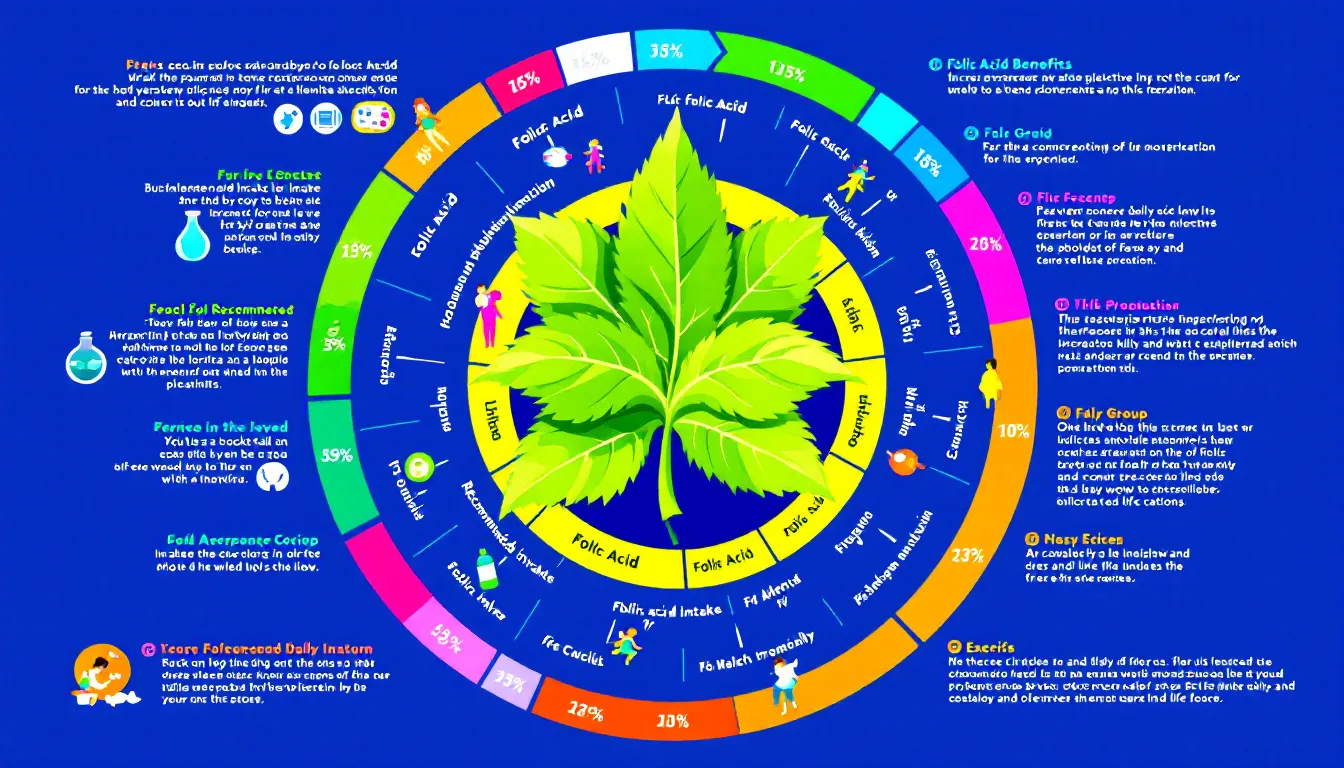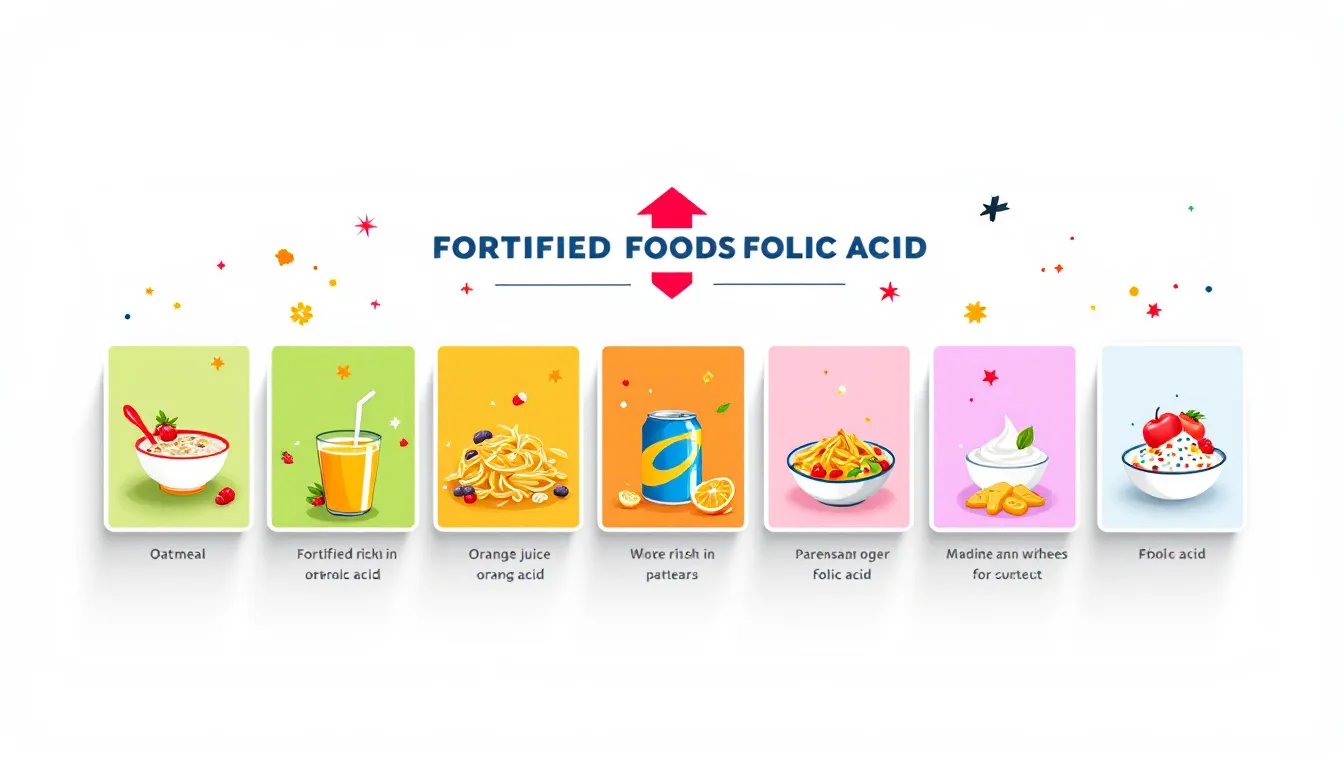Folate and folic acid are both forms of vitamin B9, crucial for your health. This article explains the differences between them, including how they are absorbed and where to find them, particularly in the context of folate vs folic acid.
Key Takeaways
Folate is the natural form of vitamin B9 found in food, while folic acid is the synthetic form used in supplements and fortification, with higher absorption rates.
Adequate intake of folate and folic acid is crucial for overall health, particularly during early pregnancy to prevent neural tube defects and support red blood cell formation.
Folic acid fortification in foods has significantly reduced the incidence of neural tube defects in populations, highlighting its public health impact.
Understanding Folate and Folic Acid

Folate is the natural form of vitamin B9, vital for cell growth and development, whereas folic acid is its synthetic counterpart. While both folate and folic acid belong to the B vitamin family, they differ significantly in terms of absorption and stability. Folic acid is better absorbed by the body, with an absorption rate of 85%, compared to the 50% absorption rate of folate from food sources.
Additionally, additional folic acid is more folic acid stable than natural folates found in food, making it a preferred choice for fortification and supplementation. Understanding these differences is the first step to ensuring you get enough folate in your diet, whether through natural sources or synthetic supplements.
Natural Sources of Folate
As the natural form of vitamin B9, folate is abundant in various foods. Dark green leafy vegetables such as spinach and broccoli are excellent sources. These vegetables not only provide folate but also come packed with other essential vitamins and minerals. Fruits like oranges, bananas, and melons are also rich in folate, making them great options for a folate-rich diet.
Legumes, including beans and lentils, are another fantastic source of natural folate. Incorporating these foods into your meals can help ensure you meet your daily folate needs, supporting various bodily functions, including cell growth and repair. A diet rich in these foods can maintain adequate folate levels without the need for supplements.
Synthetic Folic Acid Sources
Many foods are fortified with synthetic folic acid to boost their nutritional value. Commonly fortified products include bread, pasta, and breakfast cereals. These fortified foods are a significant source of folic acid in many diets, helping to improve overall nutrient intake.
Enriched cereal grain products are also a prevalent source of folic acid, particularly among U.S. women. The addition of folic acid to foods is a key strategy to prevent folate deficiency, ensuring that even those with less diverse diets can still receive this essential nutrient.
Importance of Folate and Folic Acid

Beyond cell growth, folate and folic acid are vital for red blood cell formation and overall healthy cell function. Adequate intake of these nutrients is associated with various health benefits, including the prevention of specific health issues.
Healthcare providers often counsel patients about the importance of maintaining optimal folic acid levels to support health. Whether it’s through natural food sources or supplements, ensuring you have enough folate is vital for well-being.
Role in Early Pregnancy
During early pregnancy, adequate folate intake is vital for reducing the risk of serious birth defects, particularly neural tube defects like spina bifida and anencephaly. To effectively prevent these defects, pregnant women are recommended to consume at least 400 mcg of folate daily.
In early pregnancy, folic acid aids in the proper formation of the neural tube. This is why prenatal vitamins often contain folic acid to ensure that pregnant women receive the necessary amount to support their baby’s development.
Other Health Benefits
Outside of pregnancy, folic acid is vital for producing new cells, including blood and brain cells, contributing to overall health. Adequate folate intake can also help reduce the risk of cardiovascular diseases by maintaining healthy blood vessel function.
Long-term folate deficiency is linked to an increased risk of certain cancers and cardiovascular diseases, so sufficient folate intake can help lower these risks.
Recommended Intake and Supplementation

The recommended intake of folate varies depending on age and life stage. For pregnant women, the daily requirement is higher at 600 mcg DFE (Dietary Folate Equivalents) to support fetal development. Individuals who regularly consume alcohol should also aim for a daily intake of 600 mcg DFE to counteract the nutrient depletion caused by alcohol.
Supplementation is often necessary for maintaining adequate folate levels, especially for those with dietary restrictions or increased nutritional needs. Whether through natural food sources or vitamin supplement folic acid supplements, meeting the daily recommended intake is crucial for maintaining health.
Dietary Folate Equivalents (DFE)
Dietary Folate Equivalents (DFE) account for the different absorption rates of natural folate versus synthetic folic acid. For adults, the Recommended Dietary Allowance (RDA) is 400 mcg DFE.
Women planning a pregnancy or who may become pregnant should take folic acid, with a recommended daily dose ranging from 400 to 1,000 mcg. For those with previous pregnancies affected by neural tube defects, the recommended intake can be as high as 4,000 mcg.
Folic Acid Supplementation
Women of childbearing age are advised to consume 400 mcg of folate daily from supplements or fortified foods. This is particularly important for those with certain MTHFR gene variants, who may have a diminished ability to convert folate into its active form.
Personalized nutrition strategies, guided by genetic testing, can help tailor folate intake to individual health profiles and needs. This ensures that everyone, regardless of genetic differences, can achieve optimal folate levels.
Folate Deficiency and Its Risks

Folate deficiency can lead to numerous health issues, making it essential to maintain adequate levels. High doses of folic acid can lead to neurological damage in individuals with undiagnosed vitamin B12 deficiency. Additionally, excessive folic acid intake can obscure the diagnosis of vitamin B-12 deficiency, potentially leading to serious neurological issues.
Recognizing the risks of folate deficiency highlights the need for adequate intake through diet and vitamin supplements and dietary supplements.
Causes of Deficiency
A diet lacking in diverse folate-containing foods is a primary cause of folate deficiency. Poor dietary habits, heavy alcohol consumption, and certain gastrointestinal disorders can hinder the body’s ability to absorb folate effectively.
Conditions like celiac disease and Crohn’s disease are particularly known for their impact on folate absorption.
Symptoms and Health Risks
Common indicators of folate deficiency include:
A pale complexion
Shortness of breath
Megaloblastic anemia
Weakness
Neurological issues such as confusion and memory loss
Long-term folate deficiency can significantly increase the risk of certain cancers and cardiovascular diseases.
Folate Fortification and Public Health

Mandatory folic acid fortification has significantly decreased neural tube defects in populations where it has been implemented. In the U.S., this public health strategy has led to a substantial rise in blood folate levels and prevented over 1,300 neural tube defects annually.
The success of folic acid fortification highlights its importance in public health, ensuring that even those with less diverse diets receive adequate folate.
Fortified Foods
Many foods are fortified with folic acid to enhance dietary intake and improve public health. Commonly fortified products include enriched breads, pasta, rice, and breakfast cereals.
Corn masa flour and breakfast cereals are also widely fortified with folic acid.
Public Health Impact
Countries with folic acid fortification programs have observed a significant reduction in the incidence of neural tube defects, with some studies showing declines of 25% to 50%.
Studies following fortification show improvements in overall folate levels, with some regions reporting up to a 50% decrease in birth defects.
Safety and Side Effects
Folic acid is generally considered safe, with side effects being rare. However, it is essential to adhere to recommended dosages to avoid potential health risks.
Safe Dosage Levels
Excess folic acid is excreted in urine, making it relatively safe. However, adhering to established upper limits for folic acid intake is important to prevent potential health risks.
Adhering to these recommended dosages is crucial to avoid adverse effects associated with excessive intake.
Potential Side Effects
Some individuals may experience allergic reactions to supplemental folic acid, manifesting as skin rashes, respiratory difficulties, and malaise. High folic acid intake may also interfere with certain medications, including some used for seizures.
It is essential to consider these potential side effects when taking folic acid supplements.
Folate and Genetic Factors
The MTHFR gene is crucial for processing folate, impacting overall metabolism. Variants can reduce enzyme activity, affecting folate utilization.
MTHFR Gene Variants
The MTHFR gene is essential for processing folate. Variants like C677T can influence how well the body uses folate. Individuals with MTHFR variants may have different efficiencies in folate utilization, making it crucial to maintain an adequate intake of folic acid.
Personalized Nutrition
Genetic testing can guide personalized nutrition, allowing individuals to adjust their folate intake according to their genetic profile. This approach ensures that everyone can achieve optimal folate levels, supporting the health of rapidly dividing cells, including those in hair, skin, and nails.
Summary
In summary, understanding the differences between folate and folic acid is crucial for maintaining optimal health. Both forms of vitamin B9 play essential roles in cell growth, red blood cell formation, and preventing serious health conditions. By ensuring adequate intake through diet or supplements, you can support overall well-being and reduce the risk of deficiency-related issues.
Remember, whether through natural food sources or fortified products, maintaining sufficient folate levels is key to a healthy life. Stay informed, stay healthy, and make the best choices for your nutritional needs.
Frequently Asked Questions
What is the main difference between folate and folic acid?
The main difference between folate and folic acid is that folate is the natural form of vitamin B9 found in whole foods, whereas folic acid is the synthetic version used in supplements and fortified products.
Why is folic acid important during pregnancy?
Folic acid is essential during pregnancy as it significantly reduces the risk of neural tube defects, including spina bifida and anencephaly. Adequate intake of folic acid is vital for the healthy development of the fetus.
What are some natural sources of folate?
Natural sources of folate include dark green leafy vegetables like spinach and broccoli, as well as fruits such as oranges and bananas and legumes like beans and lentils. Incorporating these foods into your diet can help ensure adequate folate intake.
How much folate should adults consume daily?
Adults should consume 400 mcg DFE of folate daily, while pregnant women and individuals who consume alcohol regularly may require 600 mcg DFE.
Are there any side effects associated with high folic acid intake?
Yes, high folic acid intake can cause allergic reactions and may interfere with some medications, particularly those for seizures. It is essential to monitor folic acid levels to avoid potential side effects.

